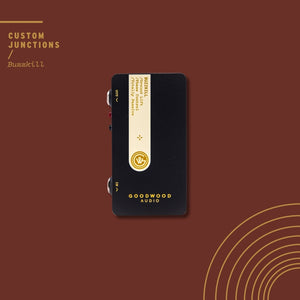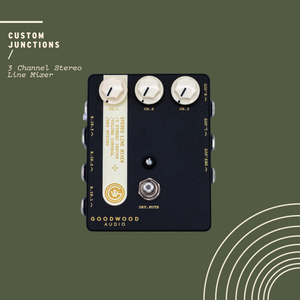You have no items in your shopping cart.
Use one pedalboard for your electric and acoustic guitar! All of the routing is taken care of by the AC/EL on the fly!
Custom Pedals like this one are built to order and therefore come with a lead time after purchase. Currently the wait time for this junction is an estimated 8 weeks before it is ready to ship.
AC/EL's purpose in life
You may be asking yourself, 'Why would I need a junction like this?'. Firstly, this box is not for everyone! It is designed specifically with musicians that want to bring one pedalboard to a gig and use it for both electric and acoustic guitars.
How does it work?
In short you can plug in both of your instruments into the inputs, 'Elec' and 'Ac' (this may blow some minds but 'Elec' stands for 'Electric' and 'Ac' stands for 'Acoustic'). You are not bound to acoustic and electric instruments! Use whatever you like. Synth, Kazoo, Bass... Just so long as it has a 1/4" unbalanced output.
When 'Electric' is live, signal will go through both the Electric Send and Return loop and the stereo Wet Effect Loop of the box ('Wet.Send, L.In, R.In) and signal will be routed to the 'El.L' and 'El.R' outputs.
When 'Acoustic' is live, signal bypasses the Electric Send and Return loop ('El.Send' and 'El.Rtrn'), sends signal straight to 'Wet.Send' (Wet Effect Loop) and also changes the outputs to the stereo outputs dedicated to acoustic ('Ac.L' and 'Ac.R').
The best thing about this?! The 'Tuner' out jack is shared between both inputs and loops. You can use one tuner for both instruments!
As well as the 'Mute' footswitch will act as a master mute across all outputs!
IMPORTANT NOTE - Even though this box is stereo capable, you can use it in mono. Just don't connect anything to the 'R.In' jack and keep the box in 'stereo' mode (white push button 'out')
Selectable options
Acoustic Outputs:
a. 1/4" Outputs only - This option will give you all of the same routing options described / shown in the video. The main difference being that you will only have 1/4" outputs and NO balanced/XLR outputs will be included.
b. 1/4" and XLR Stereo Outputs - Similar to the video you will be given both XLR and 1/4" stereo acoustic outputs. Ground lift and phase is included as standard on balanced outputs.
Isolation For Electric Outputs:
a. You can opt to have standard 1/4" electric outputs with NO ground lift and phase control. This means if you're running multiple outputs on AC/EL and you get a ground loop or phase issue you won't be able to correct it with AC/EL.
b. You can opt to have a transformer isolated output for electric. This means you will get a ground lift and phase toggle for the right electric output to help correct any ground loops or phase issues between your electric amps!
Manual & Specs
Although you do not need to specifically use an Acoustic and Electric guitar with this box, that is how we will refer to the routing and use in this section. Feel free to use other instruments as you see fit - Electrics, Bass Guitars, Acoustics, Synth etc.
Input Section
There are two instrument inputs on this junction - 'Elec' and 'Ac'.
These two inputs relate to the rest of the box and how it will auto-route your signal so make sure you plug in correctly!
The input section is responsible for a few different tasks:
a. Decide which input is used - either 'Elec' or 'Ac'. From there...
b. Send the live signal to the tuner output and...
c. Send the signal to either the 'El.Send' (if in Electric mode) or the 'Wet.Send' if in 'Acoustic' mode.
One note on the input section. We are aware that not every muso will want to use two cables for their two instruments and therefore two inputs are not necessary. If you would rather use one cable, unplug your electric and plug in your acoustic (while the master mute is on of course) this is also an option! Simply plug your ONE cable into the 'Elec' input and leave the 'Ac' input with nothing plugged in. In this configuration the rest of the box will route as normal and the 'Elec' input will work no matter what mode you're in!
Loops
There are two loops on the AC/EL junction:
1. Electric Loop - Designed for dry effects that you would typically only use for electric guitar - Overdrive, Fuzz, Distortion etc. This loop has one mono send, 'El.Send' and a mono return, 'El.Rtrn'.
2. Wet Effects Loop - Designed for shared effects between your acoustic and electric - Chorus, Delay, Reverb etc. This loop has a mono send, 'Wet.Send' and a stereo return, 'L.In' and "R.In'.
Summing
There are a few different summing options available depending on which instrument you want to use in mono and which you want to use in stereo.
Firstly, the global summing options.
By default, your AC/EL will ship in Stereo Sum mode. This means that, when summed (pushbutton IN) the Left and Right inputs will be summed and then sent to ALL outputs (Electric and Acoustic) on the junction.
If you want to access Split Sum (the right input is muted and the left input is sent to both the Right and Left Output jacks), open up your AC/EL and flip the DIP switches according to the directions on the PCB. This PCB is attached to the Left and Right Input jacks.
The above options are great if you want global summing. However, often customers want the Electric side in stereo and the Acoustic side in mono. What then? Give up and go home? Never.
If you only want one side of your AC/EL in stereo and the other in mono simply plug in the Left output jack only of the side you want in mono. This will tell the box that you want to sum that side only and leave the other in stereo.
**Note that this only works for the 1/4" outputs. If you have LongLine (XLR outputs) on your box they will always be in the state of the global stereo/sum option. If the pushbutton is IN your XLR outputs will be summed, if OUT, they will be in stereo.
Outputs
You can choose to have a few different output options.
a. 1/4" outputs - All outputs across the Acoustic and Electric side of the junction will be unbalanced 1/4" jacks.
b. Stereo LongLine outputs on the Acoustic outputs of the box - Adding this option allows you to run XLR cables directly from your AC/EL straight to FOH bypassing any DI's on stage. These are buffered sends and have a strong, low impedance signal!
c. Stereo LongLine outputs on the Electric Side of the box - This is a great option if you plan on using an Amp/Cab sim (ideally placed last in your Electric Mono Loop) and want to send balanced outputs to FOH.
If you get a little sick to your stomach when people start talking about amp and cab sims, you can also use LongLine (XLR) on the Electric outputs to send to a real tube amp up to 300 feet away in an iso booth. You will need RCV to convert the balanced signal back to unbalanced 1/4" outputs, but in this way LongLine is a dual purpose circuit that will keep your rig flexible for years to come!
**Note that there is not enough room on the box to add LongLine outputs across Acoustic and Electric at the same time, you will have to choose between one or the other or get a custom junction designed to your specific needs.
Isolation - Ground Lift and Phase
Although this is technically part of the output section listed above, it deserves it's own section.
If you run more than one output at the same time you have the possibility of running into ground loops (a loud hum in your amps/lines) and phase issues (when frequencies between amps fight each other (not literally - that would be crazy) and cancel each other out). Two amps that are out of phase typically sound honky - like a Goose has gotten into your rig - and the low frequencies will be diminished.
Although FOH (the sound engineer) can fix phase issues at the sound desk for direct lines, it is harder to fix phase issues between mic'd amps.
You typically won't need a transformer on your 1/4" Acoustic Outputs as the DI's you'll plug into typically have ground lift built in and the sound desk can correct phase.
On the Electric Outputs however - which generally send to amps - If you plan on running more than one amp at a time for gigging purposes, you should strongly consider getting the added transformer to protect against ground loops and phase issues between your electric amps.
If you select LongLine outputs for either the acoustic or electric outputs, ground lift and phase are included in the price by default.
Footswitches
There are two footswitches on board the AC/EL junction box.
1. 'Mute' - This is a Mute or Kill switch. Don't worry, you're not giving some secret signal to a nearby assassin to carry out their hit. This will ONLY kill your guitar signal. Temporarily. More of a 'Stun' switch.
Hit this switch and no signal will carry on to any of your outputs. No electric outputs, acoustic, LongLine etc. Use this switch to tune, re-patch your board, change guitars etc.
2. 'Instrument' - Use this switch to select which mode the junction will be in. Select 'Ac' and your acoustic input will send to the:
Tuner out/Wet Loop - Acoustic Outputs.
Select 'El' and the electric input will send to the:
Tuner/Mono Electric Loop - Wet Loop - Electric Outputs.
Custom Junctions are designed to last and come with a 2 year warranty!
All Custom Junctions are made with high quality, durable components.
IMPORTANT - Use only 9vDC centre negative plug to power!
Current Draw/Power: 150mA, Center Neg 2.1mm
AC/EL Box Dimensions: 145mm x 121mm x 55mm
Input Impedance: 1Meg
Output Impedance (1/4" Outputs): 500ohms
Low impedance XLR outputs (if included).
Balanced Output Specs (When using LongLine in place of a DI)
Freq. Response: 20Hz - 20kHz
Dynamic Range: 93dB
THD: 0.005%
Low Output Impedance
We know the best part about buying a new product is receiving that freshly wrapped package in the mail. The worst part however, is the agonising wait of what seems like decades for it to arrive. We will always do our best to get your newly purchased product to you in a timely manner.
Domestic
All orders are sent via USPS and generally ship within 1-5 business days.
If you don't receive a tracking number from us after purchase, first check your junk folder, then send us an e-mail and we will find it for you!
International
We use USPS and UPS for International shipping. Since Covid hit, international shipping has been very hard to predict with any certainty. Please be patient and don't be alarmed if your order takes a bit longer than normal!
Unfortunately we have no control on how long the package will take to arrive once it has shipped. If your package does not arrive within the time mentioned above, simply send us an email, SMS, letter via carrier pigeon or come tell us in person and we will do our best to look into it from our end.
























